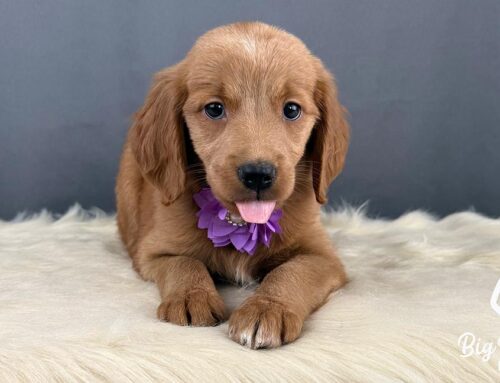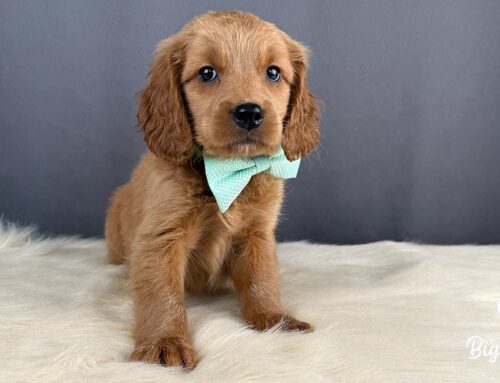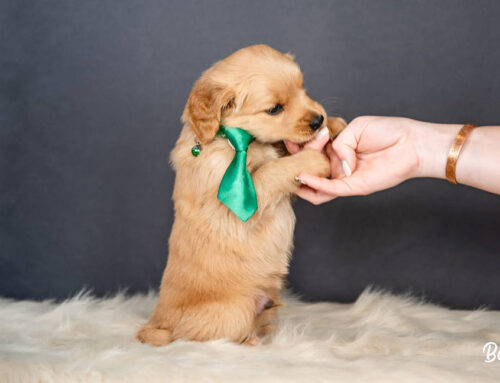The Benefits of Positive Reinforcement Training
 At Big Hearted Breeders, we’ve always believed that how you teach your dog is just as important as what you teach. From the moment our Mini Golden Retriever puppies open their eyes, they’re surrounded by encouragement, kindness, and praise—because that’s how real, lasting learning begins.
At Big Hearted Breeders, we’ve always believed that how you teach your dog is just as important as what you teach. From the moment our Mini Golden Retriever puppies open their eyes, they’re surrounded by encouragement, kindness, and praise—because that’s how real, lasting learning begins.
We use positive reinforcement training with every puppy we raise, because it’s one of the most effective, relationship-building methods available. But it’s not the only tool in the box. In fact, we believe in a balanced approach to training—one that blends rewards-based learning with thoughtful boundaries and clear expectations.
If you’re wondering how to best guide your Mini Golden puppy toward good manners and lifelong success, this post will walk you through why positive reinforcement is powerful, and how a balanced approach can help your dog thrive.
What Is Positive Reinforcement Training?
 In short, positive reinforcement training means rewarding your dog for doing something right. Instead of focusing on punishment for “bad” behavior, we shine the spotlight on the good behavior we want to see more of.
In short, positive reinforcement training means rewarding your dog for doing something right. Instead of focusing on punishment for “bad” behavior, we shine the spotlight on the good behavior we want to see more of.
Rewards can include:
- Treats
- Praise
- Belly rubs
- Playtime
- A favorite toy
This method builds your dog’s confidence, helps them learn faster, and creates a positive association with training. Dogs love knowing they’re doing the right thing—and Mini Goldens, in particular, thrive when they feel your encouragement and approval.

Why We Use Positive Reinforcement Training at Big Hearted Breeders
At Big Hearted Breeders, we use positive reinforcement training because:
- It nurtures trust. Puppies feel safe and supported when they know what to expect.
- It boosts learning. When dogs enjoy training, they learn faster and retain more.
- It encourages cooperation. Instead of obeying out of fear, your dog listens because they want to.
- It supports emotional development. Confident, secure dogs make calmer, happier companions.
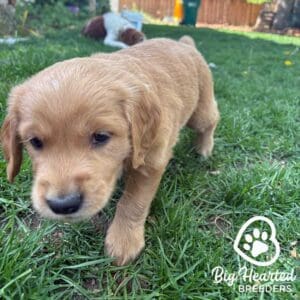 By the time our puppies go home, they’ve already been introduced to foundational commands like “sit,” “come,” “kennel,” and “place” using positive reinforcement training. Many even begin house training and crate comfort training—all with praise, patience, and a few tasty rewards.
By the time our puppies go home, they’ve already been introduced to foundational commands like “sit,” “come,” “kennel,” and “place” using positive reinforcement training. Many even begin house training and crate comfort training—all with praise, patience, and a few tasty rewards.
That said, our training is not limited to just rewards. Puppies also need structure, redirection, and gentle correction when necessary. For example, calmly removing attention when a pup is jumping or redirecting chewing behavior to an appropriate toy. These techniques aren’t harsh—they’re thoughtful. They help puppies understand boundaries and learn to make better choices.
We believe in meeting puppies where they are and guiding them with a mix of compassion, clarity, and consistency.

The Science Behind It
Positive reinforcement training isn’t just a “feel-good” method. It’s backed by science and supported by veterinarians, trainers, and behaviorists worldwide.
Here’s why it works:
- Dogs repeat behaviors that bring good results
- Reinforcement strengthens the connection between the behavior and reward
- Consistent, clear feedback teaches them what you expect without confusion or fear
Mini Golden Retrievers are intelligent, intuitive, and people-oriented—making them ideal students for this kind of training.
Real-Life Examples of Positive Reinforcement Training
Let’s break down a few everyday examples:
 Potty Training
Potty Training
Instead of scolding accidents, you reward your pup every time they potty outside. Over time, they associate going outside with praise and treats, making them eager to repeat it.
Learning “Sit”
You say “sit” and gently guide your puppy into position. The moment their bottom hits the floor, you reward them. That reward makes the behavior stick—and soon, they’ll sit before you even ask.
Curbing Jumping
When your pup jumps up, you calmly turn away and ignore the behavior. When they stand or sit calmly, you reward that. They quickly learn which behavior gets attention—and which doesn’t.
 How Positive Reinforcement Training Builds a Stronger Bond
How Positive Reinforcement Training Builds a Stronger Bond
Training shouldn’t feel like a chore. It should feel like a game you’re playing together—and that’s exactly what positive reinforcement makes possible.
When your dog sees you as their guide and cheerleader, they trust you more deeply. They look to you for direction, and that connection becomes the foundation of your relationship.
Training isn’t just about obedience—it’s about communication. And every treat, smile, and “good dog!” builds a conversation you’ll continue for years.
Common Myths About Positive Reinforcement
 “They’ll only behave if I have treats.”
“They’ll only behave if I have treats.”
Not true. Treats are used to teach. Once your dog understands the behavior, you can slowly phase out food rewards and replace them with praise, petting, or play.
“It doesn’t work for stubborn dogs.”
Even independent pups respond well to positive reinforcement—it just takes consistency and the right motivator. Every dog wants something; you just have to find what it is.
“It’s not serious training.”
Positive reinforcement is highly effective, even in professional settings like service dog programs, police dog training, and behavioral rehab. It’s not just nice—it works.
 What Makes Mini Goldens a Great Match for Positive Training?
What Makes Mini Goldens a Great Match for Positive Training?
Mini Goldens are bright, eager-to-please, and sensitive. Harsh methods can crush their spirit, but positive reinforcement builds them up.
These pups love being part of the team. They respond beautifully to reward-based learning and often excel in obedience, agility, and therapy work when trained with kindness.
That’s why we start every one of our puppies with this method. It sets the tone for a lifetime of learning, teamwork, and tail wags.
How to Start Positive Reinforcement Training at Home
- Be consistent. Reward the behavior you want, every time.
- Use high-value rewards. Think tiny pieces of chicken, cheese, or a favorite toy.
- Keep training sessions short and fun. Just 5–10 minutes a few times a day is perfect.
- Praise generously. Your voice and energy are just as powerful as treats.
- Celebrate progress. Every little win matters—make it feel like a party.
From Our Family to Yours
At Big Hearted Breeders, we don’t just raise puppies—we raise future best friends. We believe that training should feel like love in action, and positive reinforcement is at the heart of that philosophy.
When you bring home a puppy from us, you’re getting more than a dog. You’re getting a confident, joyful learner who’s already experienced kindness, encouragement, and connection—and is ready to keep learning right by your side.
 Why We Believe in Balance
Why We Believe in Balance
Positive reinforcement training is powerful—but it works best when paired with structure, boundaries, and calm corrections. Puppies, like children, thrive in environments that are loving but clear. When they know what’s expected and are guided kindly toward success, they become the calm, confident companions we all want.
At Big Hearted Breeders, we believe a balanced approach is the best approach—one that teaches with love, clarity, and consistent communication.
FAQ: Positive Reinforcement Training
What age should I start training my puppy?
You can start as early as 7–8 weeks. We begin positive reinforcement from birth with gentle touch, sounds, and early socialization.
Do I always need to use treats?
Treats are helpful at the start but can be gradually replaced with praise, petting, or other rewards once behaviors are learned.
How long does it take to see results?
Many puppies learn basic commands within days or weeks. Consistency and patience are key.
Can I use positive reinforcement to stop bad behaviors?
Yes—by ignoring unwanted behavior and rewarding the desired alternative. For example, reward calm behavior instead of jumping.
What if my puppy isn’t food motivated?
Try toys, praise, or short games as rewards. Every pup has a motivator—you just need to find it.
Looking for more tips on raising a happy, well-trained Mini Golden?
Explore our blog at Big Hearted Breeders—where love, learning, and wagging tails come first.


 Potty Training
Potty Training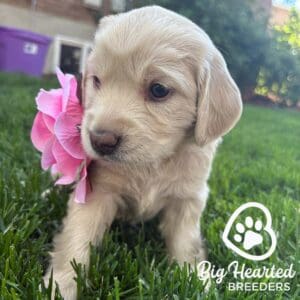 How Positive Reinforcement Training Builds a Stronger Bond
How Positive Reinforcement Training Builds a Stronger Bond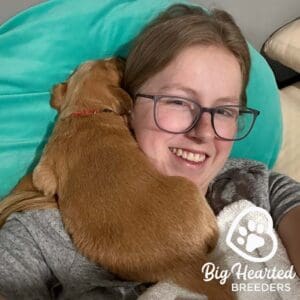 What Makes Mini Goldens a Great Match for Positive Training?
What Makes Mini Goldens a Great Match for Positive Training?
 Why We Believe in Balance
Why We Believe in Balance